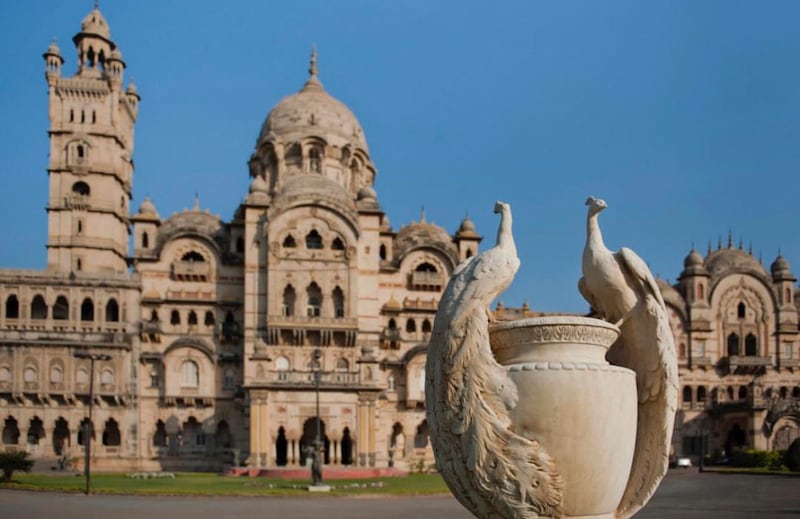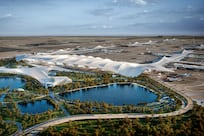Named after its abundance of banyan trees, the Indian city Vadodara is renowned for its cultural leanings. It thrives on traditions of culture, cosmopolitanism and charity.
Much of this ethos is rooted in the pluralistic vision of Sayajirao Gaekwad III, the Maharaja of Baroda State from 1875 to 1939.
A descendant of a Maratha general who wrested Baroda from the Mughals in 1721, Gaekwad was known for his foresight. Under him, primary education was made compulsory and free, child marriage and untouchability were banned, and a railway system and the Bank of Baroda were opened.
Dr Maitree Vaidya Sabnis, associate professor in the history department at the Maharaja Sayajirao University of Baroda, says Gaekwad was a visionary.
“On one hand, he hoped to provide basic facilities to his people and focused on reforms; on the other, he believed they should have access to all that populations across the world did. He created beautiful gardens, museums, patronised all art forms, and aimed for architectural splendour,” she says.
Sabnis says the maharaja developed Baroda, as Vadodara is also known, into the cultural capital of Gujarat, “a position it still holds today”.
Sayajirao’s cultural bequeaths are visible across the city: a university named after him, a central park, waterworks scheme, and numerous architectural monuments.
Of these, one stands out. The Laxmi Vilas Palace, commissioned by Gaekwad ahead of his wedding to Chimnabai I of Tanjore.
At the time the palace was constructed, it was the largest private home in the world. Built over 12 years for £180,000 ($220,720), with a compound spread over more than 202 hectares, it has 170 rooms and is more than three million square feet, making it about four times the size of Buckingham Palace. The maharaja had to commission a mini train to ferry his children to school each day.

The structure was started by British royal engineer Major Charles Mant in 1878 and finished by British architect Robert Chisholm. As a college student studying architecture, at the University of Baroda, I heard stories of how Mant, midway through the project, felt that he had made a structural mistake and died by suicide.
However, decades later, the stories remain unsubstantiated and the palace continues to stand tall as home to the royal family of Vadodara, led by Samarjitsinh Gaekwad.
His wife, Radhikaraje, says the palace, apart from being a public monument loved by the people, is also a home associated with numerous family memories.
“I moved in 21 years ago after my marriage and the palace is a repository of memories – my first homecoming, the birth of my daughters, the coronation ceremony,” she recalls.
Native architecture
Crafted from golden stone, the palace exemplifies Indo-Saracenic architecture, a revivalist style often used by British architects in the later 19th century. It blends elements from native architecture, including Rajasthani, Gujarati and Islamic, with European forms.
The facade is rich with elements such as domed chhatris with finials, cusped arched openings, and jharokhas (windows). Carved stone motifs, brackets, and bands of sculptures and paintings embellish the exterior.
The skyline is impeccable – a central cupola, a tall tower, chhatris, and Bengal roofs. The tower was initially meant to house a clock, which made way for a red light to indicate if the king was in residence.
Sabnis says the palace is known for its opulent architecture and extensive collection of paintings and decorative items.
“The interior showcases a blend of various architectural styles, including Baroque, Rococo, and neo-Gothic, reflecting the eclectic tastes of that era.”
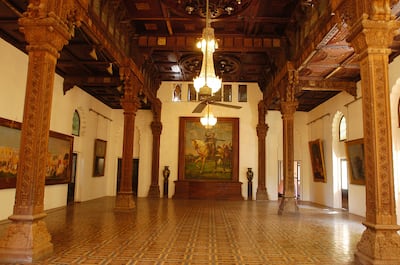
The elaborate interiors are rich in mosaics, chandeliers, and artworks, and include a collection of weaponry and art.
Chandrashekhar Patil, historian and art conservationist, reveals that the ornate Darbar Hall, showcasing a lacquered ceiling with geometric patterns, Moroccan mosaic floors, and Belgian stained-glass windows and glass murals made in Germany, was originally used to discharge courtly duties along with grand cultural events.
The hall, which opens up into an Italianate courtyard with water fountains and sculptures, remains a sought-after venue. Other rooms include the Veena room, inspired by the Ajanta caves, and the Gulabi room, done up in understated pinks, creams, and beige with murals of angels and cupid, which served as a private parlour for Chimnabai.
“The palace has an impressive collection of old armoury and sculptures in bronze, marble, and terracotta by many artists, including Italian artist Fellici,” Patil says.
Marble from Carrara, glasswork from Murano, golden sandstone from Jaisalmer, red stone from Pune, plasterwork artists from Madras – no effort and expense was spared.
Gaekwad, a craft conservationist, says about 25 per cent of the palace is open to the public. She offers further details of her “very, very beautiful home”. “The family uses a few spaces regularly: three drawing rooms, two large dining rooms, one large hall, living suites, and more.”
Modern amenities
The palace was built with all possible modern amenities, including an internal telephone exchange, elevators, and electrical supply.
“The three elevators were the first in Gujarat. Of these, only one is functional, but we keep maintaining it as we don’t want to bring in modern steel to replace vintage wood,” she says.
The expansive grounds, including a golf course, were landscaped by William Goldright, a specialist from Kew Gardens.
Sabnis says the palace gardens have always been impressive. “The gardens had tennis courts, a riding track, school, library, cricket ground, and a large central hall used for luncheons. The drive led to the maharaja’s private railway station on the Bombay and Baroda main line.”
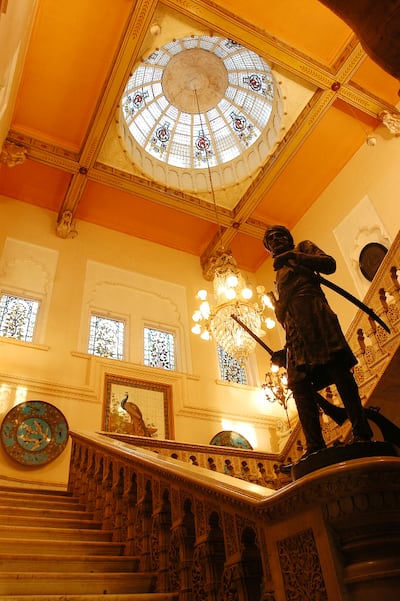
There was also a zoo. Now, only a pond with some crocodiles remains.
The grounds also house the Maharaja Fatehsingh Museum, built as the school the maharaja's children were ferried to and from in the miniature railway. The refurbished engine stands at the entrance to the museum that showcases a selection of art pieces, including European Renaissance and Rococo paintings, portraits, marble busts, and a range of Raja Ravi Varma’s paintings.
“The artist was a privileged guest during Sayajirao’s rule, and stayed in a studio on the grounds. Ravi Varma created 40 paintings, including some of his most iconic works, while in Vadodara. The Sita Bhoomi Pravesh and portraits of Sayajirao and Chimnabai are among them,” Patil says.
More than 25 of Ravi Varma’s paintings are on display at the museum.
Social gatherings
The Moti Bagh Cricket Ground houses the offices of the Baroda Cricket Association along with teak-floored tennis and badminton courts. The golf course, renovated in the 1990s, is open to the public.
The palace now also runs a commercial offshoot: LVP Banquets and Conventions, a space for social gatherings, weddings, and celebrations.
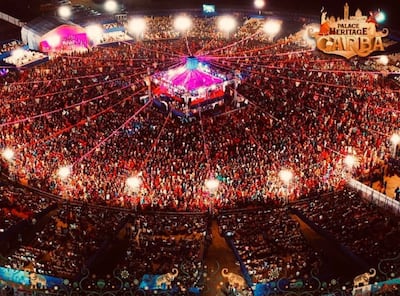
“We didn’t want to turn Laxmi Vilas Palace into a hotel, but wanted to make it accessible,” Gaekwad says.
The desire to keep the community close led her to launch Laxmi Vilas Palace Heritage Garba, an event that brings the palace alive during Navratri.
The nine-night festival is celebrated with the garba, a sublime dance form that seems to emulate life. Dancers twirl gracefully in concentric circles that depict the circle of life. In the centre, an earthen lamp placed in front of Goddess Durga honours the fight against good and evil, a fight that she won against a demon king.
Gaekwad, a self-confessed garba lover, says the event makes the palace interactive, relatable and relevant. “The palace is part of Baroda’s past and this way we make it a part of people’s present,” she says.
Architect Sonali Lele Desai feels that Laxmi Vilas Palace, which held significant cultural relevance historically, continues to be vital. “It has symbolised the Gaekwads’ wealth, power, and patronage of arts and creativity for decades, and is a reminder of the ruler’s futuristic vision for his people and city.”
